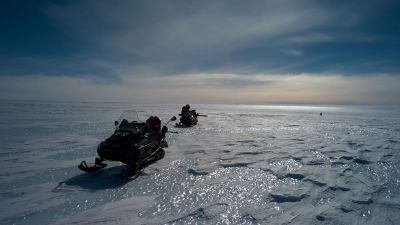
We Are StarDust
To paraphrase PJ O’Rourke, as hell holes go, this was a fine example. Perhaps less hospitable places exist on the planet, but I have yet to taste of their joys.
The Nansen Isen, as they are known, lie out on the Antarctic Plateau, a little to the south of DufekFjellet. Acres of ancient blue ice carved into uncompromising ribbed, ridged, rippled and reticulated forms by the relentless wind, harder than concrete, twist and buckle their way over vast acres of gently curved and seemingly endless horizon. They lie at a respectable altitude of about 2720m, but with the prevailing low Antarctic barometric pressures the effect in oxygen deficit is the same as ascending to 3500m, which is like going to the top of Mount Cook - by tractor.
As luck would have it, this is one of the richest meteorite hunting grounds on the planet. If there is a rock around, it is unlikely to be from anywhere other than from outer space. Spent meteors and asteroids that shower their way carelessly across the heavens, leave behind their “burnt offerings from the universe” liberally sprinkled all over the Earth (by some reckonings almost 40 tonnes a year). But there are few places where you can spot them so easily. There is literally nothing else here. And it is this nothingness that is in itself so poignant, and so scary. No living thing can survive here without having the life sucked out of it. The heavy, cold, catabatic wind pours off the high plateau in hissing waves and gusts sweeping away before it all intruders, like a monstrous dragon protecting its wealth. Even the ice tries to escape. What cannot escape by pouring down the glacier and cracking in its haste to slither away, sublimates as if too impatient to melt. It vaporises and is gone, a micron layer at a time, gradually, revealing, over the aeons, whatever may lie in its entrails. And it is just these entrails which are of interest because they heave up meteorites, fallen millennia ago, to their surface. Like the ancient Greeks we too pore over these entrails to read the messages from the edge of the universe.
On the 30th of December, we made our way up the Gunnestadtbreen in a happy little sunlit caravan, two Prinoths, two travelling 10-foot containers, some fuel and an accommodation module for the scientists. There are four of them. Two from Belgium (Vinciane and Steven) and two from Japan (Hiroyoshi and Tsuyoshi - although technically Tsuyoshi is the field guide, like Sanne on our side). The weather is so fine, crisp and clean with sun that we are all in good spirits. Alain is leading the convoy by skidoo to act as forward reconnaissance, a task he shares with René, who is also the cameraman. Also with us are Kristof, Chief Mechanic, SwissDoc, Erik Verhagen, our Franco-Dutch station engineer and South Pole veteran, looking for a good spot to put an experiment, and myself, as tractor driver and erstwhile meteorite seeker.
The first bit of the Gunnestadtbreen is accessed by taking a right turn due South between Teltet and the small Nunatak-with-no-name, but which shall henceforth be called the Tarantula. (The Norwegians have dibs on the best rocks, but I will get the scariest looking). The scenery is breathtaking, and the slope is not insignificant. The rock faces of Wengen and Wideroefjellet unfold to the starboard side, as we power along up the glacier.
It is about 50km to the first crevasse zone where the escaping glacier falls infinitesimally slowly over subglacial rocks and cracks in its haste to get to the ocean and escape this icy hell. Alain, Jacques Richon and René Robert have already surveyed the route, and put down bamboo poles as markers, but we still have to be careful as snow bridges hiding crevasses are of different thicknesses and may hold up a skidoo, but will fail for sure under a Prinoth. Jacques is our helicopter riding Swiss Mountain Rescue Doc and René is a Chamoniard, hardened to life in the rude Alpine climes. But both are more than a little nervous of The Plateau. Alain passed this way on skis in November 1997 when he crossed the Antarctic, towing a bone tearing three hundred kilos up this very long slope. He tends to become very silent and brooding whenever he comes here. There is no more joking. His jaw becomes set, and his eyes narrowed. With Kristof, Alain disengages the two Prinoths from the caravan. We put heavy chains between them and they head up the edge of the glacier to test the snow bridges. Should one Prinoth fall in, the other one will have to try and hold it up or pull it back out, which is, theoretically, possible seeing as the Prinoth can pull more than 40 tonnes with its 400 horsepower. Luckily we have never had to test this hypothesis.
(to be continued)
Picture: Alain and Jacques on a recon trip for the meteorites expedition - © International Polar Foundation - René Robert
